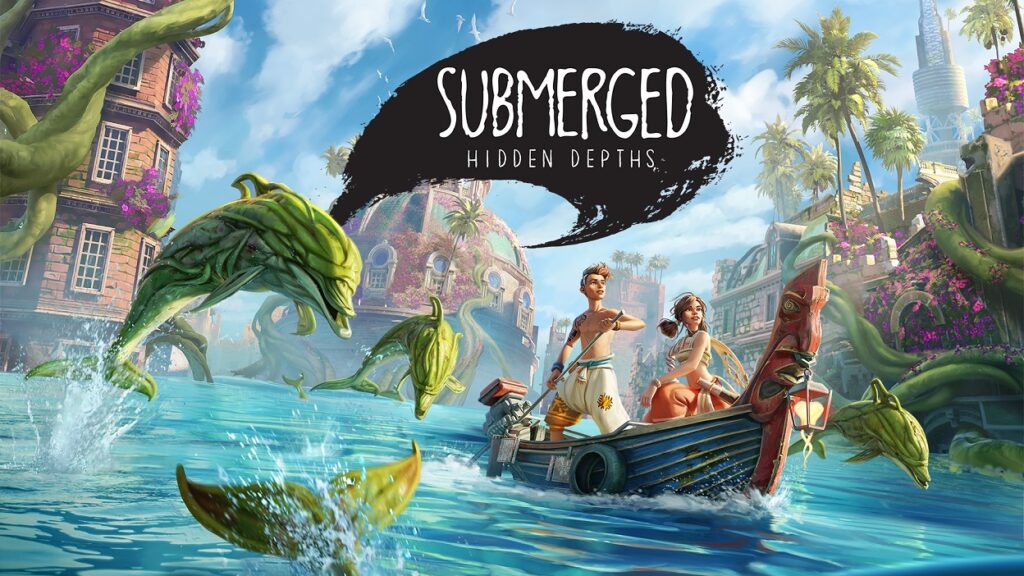
From Austalia-based indie studio Uppercut Games, Submerged: Hidden Depths is the follow-up to their non-violent exploration game Submerged released back in 2015 for PlayStation 4, PC, and mobile. The sequel was initially released on the “alive and well” Google Stadia as an exclusive in 2020, with the Stadia Games and Entertainment division assisting with its development. But after a few years of disappointing results for the underwhelming cloud streaming console, Submerged: Hidden Depths was announced for release on PlayStation, Xbox, and PC earlier this year.
Now that this game has been released onto consoles that people actually own, check out my Submerged: Hidden Depths review to learn more. Is this a hidden gem pulled from the watery grave of an abandoned console launch, or would it be better if we left it untouched at the bottom of the sea?
Submerged: Hidden Depths
Developer: Uppercut Games
Publisher: Uppercut Games
Platforms: Stadia, PlayStation 4/5, PC (Reviewed), Xbox Series X/S, Xbox One
Release Date: December 3, 2020 (Stadia), March 10, 2022 (Everywhere else)
Starting our Submerged: Hidden Depths review, the strongest aspect of this title is its visuals. The style is colorful and cartoonish, reminiscent of modern Disney movies. The main characters, Miku and Taku, have big eyes and expressive faces that do most of the heavy lifting for a pretty barebones story.
The setting for Submerged: Hidden Depths is a small patch of ocean surrounded by the crumbling remains of a once towering city. Capsized shipping vessels, vine-choked skyscrapers, and neglected industrial centers are where you spend the majority of your time. The combination of cartoonish characters with untamed nature and the tasteful addition of some Greek inspired architecture in pockets of the surging ocean brings another former Stadia exclusive to mind— Ubisoft’s Immortals: Fenyx Rising.
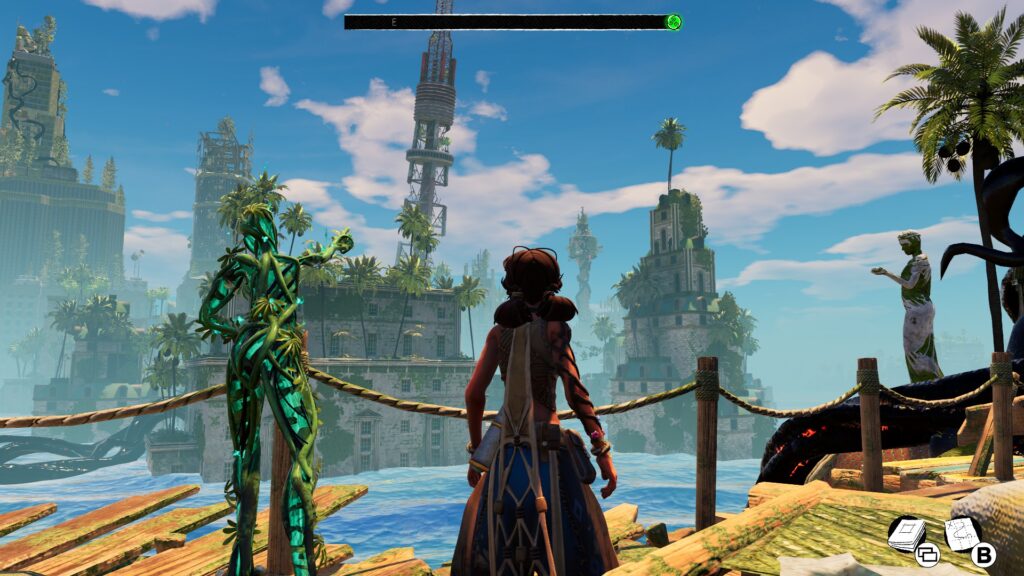
My PC with a mid-range GPU was able to run this game in 1080p on High settings with no noticeable performance issues, but you can improve the framerate by tweaking shadows, post processing, and foliage with little to no difference in visual quality.
The music is soft and minimalist, mostly piano with some strings; it’s incidental and mostly used to punctuate significant items, locations, or events throughout the game. Aside from this, you’ll spend most of your time with Submerged: Hidden Depths listening to calm ambient sounds: crashing waves, rustling leaves, and rustled features from pigeon flocks.
Overall, the setting and soundscapes truly live up to Uppercut Games’ insistence that this is a “relaxploration” title. My only criticism in this area is extremely minor and virtually unnoticeable; I noticed a slight squeak when walking on some surfaces that sounded like running shoes on a basketball court even when walking barefoot over a metal scaffold.
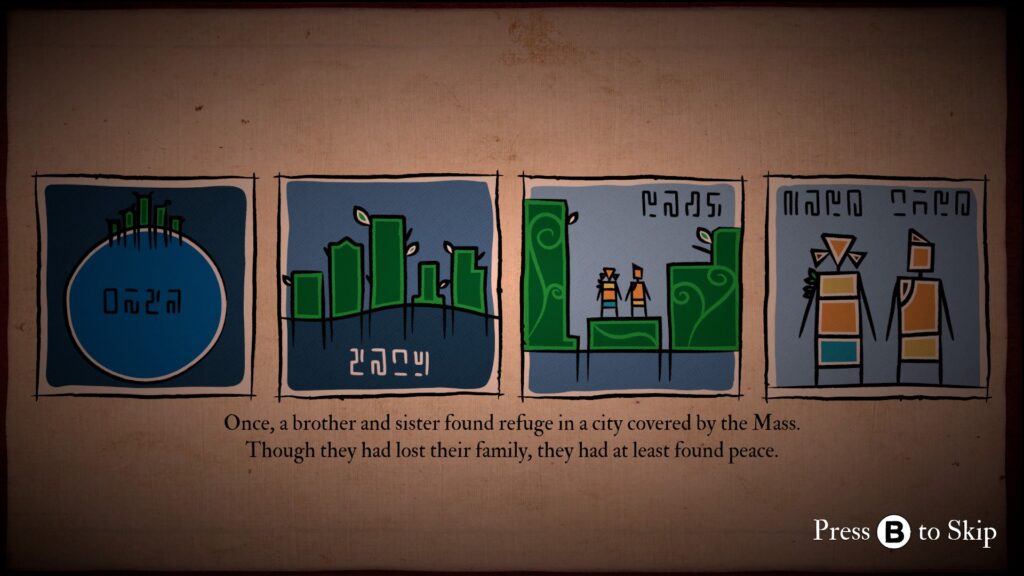
When starting Submerged: Hidden Depths, you’re presented with some exposition text and a brief cutscene, and then you jump right into the game. The two siblings speak in a made up language, but I found it odd when they would occasionally say a word or two in English. This was a rare break in the immersion derived from the game’s setting that came across as silly; it reminded me of the goofy dinosaur language in Starfox Adventures.
Bits of lore about the main characters and the once-bustling villages they explore can be discovered by searching for diaries strewn across the environment. There are also short cutscenes after each level that show vignettes of Miku and Taku’s day-to-day lives.
With so little to work with, the story of Submerged: Hidden Depths is brief and painless but not really interesting or insightful, even when their interactions become troublesome and an angry presence is introduced. There’s clearly inspiration from other minimalist game narratives, such as Shadow of the Colossus and Journey.
Aside from this, your time in Submerged: Hidden Depths is spent exploring the beautiful environment to discover collectibles and unlock paths to navigate the labyrinthine structures completely devoid of human life. There are lots of collectibles you can find in order to fill out a codex.
Discover animals, landmarks, cosmetics, upgrades to speed up your boat, and the aforementioned diary entries. You have a telescope that enables you to find and mark collectibles on your map, but you can just follow the black tendrils in the water to find each level, which is solved by picking up a seed and taking it to a centerpiece.
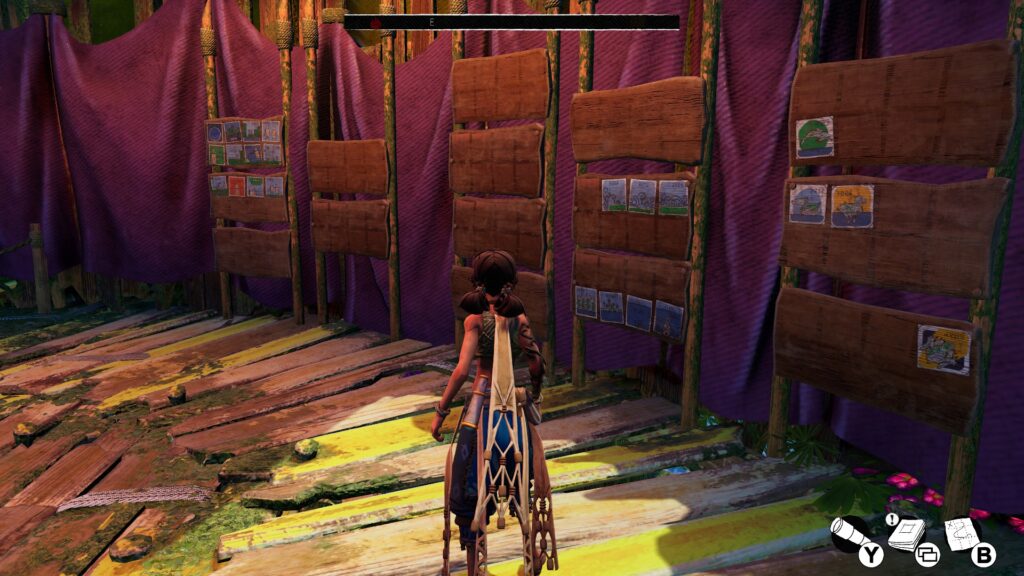
Collectibles can be seen at the home base, including a tapestry made of the story elements found in diaries and through main story progression. Other than that, it feels like a basic checklist with little reward for completion. Perhaps there is an alternate ending for collecting them, but I had no interest in sticking around to find out.
The exact moment I lost interest in ever returning to this title was when I had to climb a thing to reveal part of the map— this was amusing the first time I did it in Assassin’s Creed, but after the one millionth time doing it in every other game since then, it just feels like an insulting waste of time. However, I have to give the game credit for allowing you to skip every cutscene, and even some of the longer elevator rides.
Something else worth praising about Submerged: Hidden Depths is how well developers Uppercut Games use visual design to guide the player toward the right direction to solve each puzzle.
Early in your exploration, there’s a set of red beams that you’re required to cross in order to advance. When looking for a place to disembark from your boat, a red-painted barricade needs to be pulled open by hitching it to the back of the boat.
Another location requires you to pull buoys through the water to bridge a gap between platforms. The Thwaites Center radio tower is a standout level, a well designed vertical maze; another interesting setpiece is the skyscraper that requires you to carry a seed from the base to the top via a complicated pulley system.
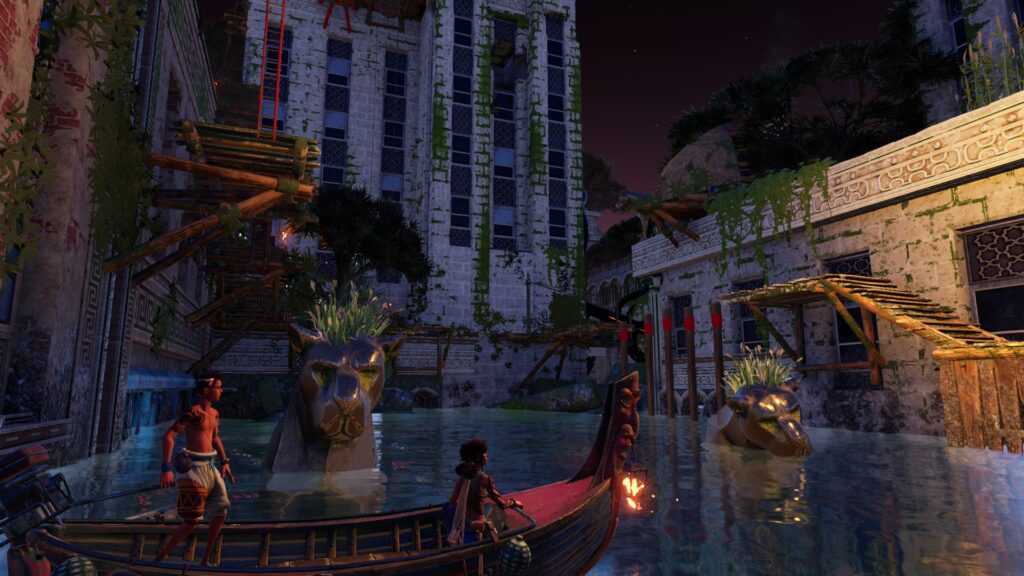
Very quickly, Submerged: Hidden Depths conditions you to look for red in the overwhelmingly green environment in order to find the correct route. But what if you’re red/green colorblind?
I noticed you can change the “guide color” in the options menu, which is a nice accessibility feature. It would have been interesting if they included the option to remove the guide color entirely, a la Mirror’s Edge disabling “Runner’s vision” in the hardest difficulty— but the option isn’t available.
Instead, I tried changing the color to yellow so it would presumably blend in better with the green and hopefully make the game a little harder, but it ended up looking like someone used a highlighter to scribble on all the important parts. It also didn’t change the color of the climbable plants— so screw the colorblind, I guess.
Here’s my biggest gripe about this game. Platforming is automatic by walking forward; your character will jump, climb, and swing to maneuver highlighted obstacles in the environment just like the N64-era Zelda games. The lack of standalone jump or climb options outside of these context specific areas is frustrating, and it actually caused me to get stuck on the environment a few times.
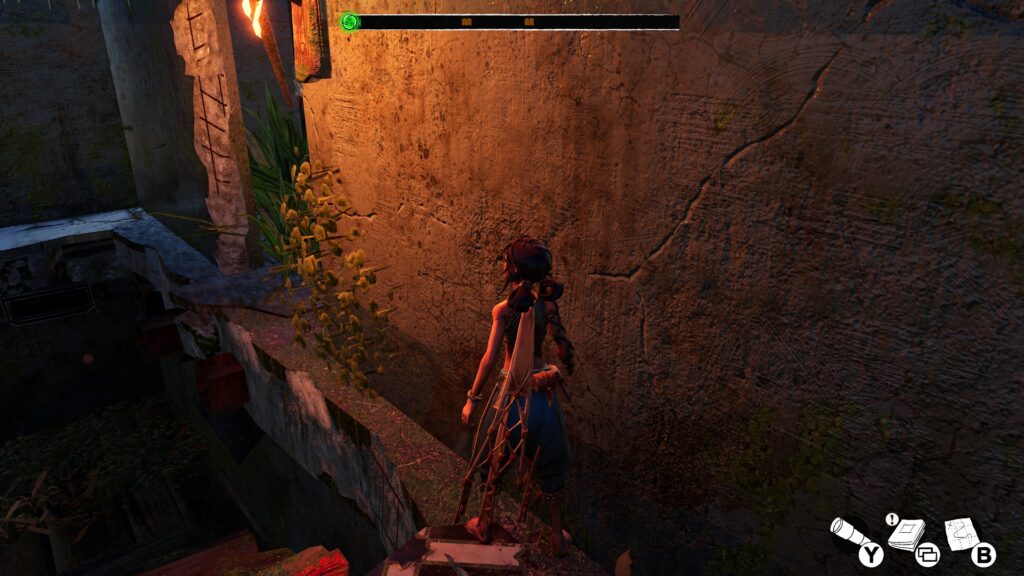
Here’s another issue I want to discuss in my Submerged: Hidden Depths review. All the levels are filled with invisible boundaries to aggressively railroad you into the right direction, look at the above screenshot as an example.
In any other game, you would assume that the character would be able to shimmy across that narrow ledge, enter the doorway, and discover some kind of secret. But instead, there’s an invisible boundary that prevents you from moving any further. There were countless areas like this where I encountered this frustrating limitation.
For a game as simple as this one, Submerged: Hidden Depths has an impressive level of polish. But occasional pathing issues and awkward fixed camera angles— presumably for “cinematic effect”— detract from the experience. Additionally, context sensitive inputs for observing animals and collecting items is noticeably laggy; at one point, I frustratingly lost the ability to register the input by pressing it too quickly while moving.
Movement is sluggish when running, but overly sensitive when using the analog stick to aim the telescope and navigate the map. It feels like it was intended to accommodate high latency, making it ideal for cloud streaming; this makes sense when you consider its origin as a Stadia exclusive.
It is my cynical belief that the slow running speed and boat speed (although you can upgrade the boat speed later) is an attempt to artificially lengthen the time it takes to beat this game. I managed to beat Submerged: Hidden Depths in about 3 1/2 hours during a single play session, but finding all the collectibles might stretch that to 5 or 6.
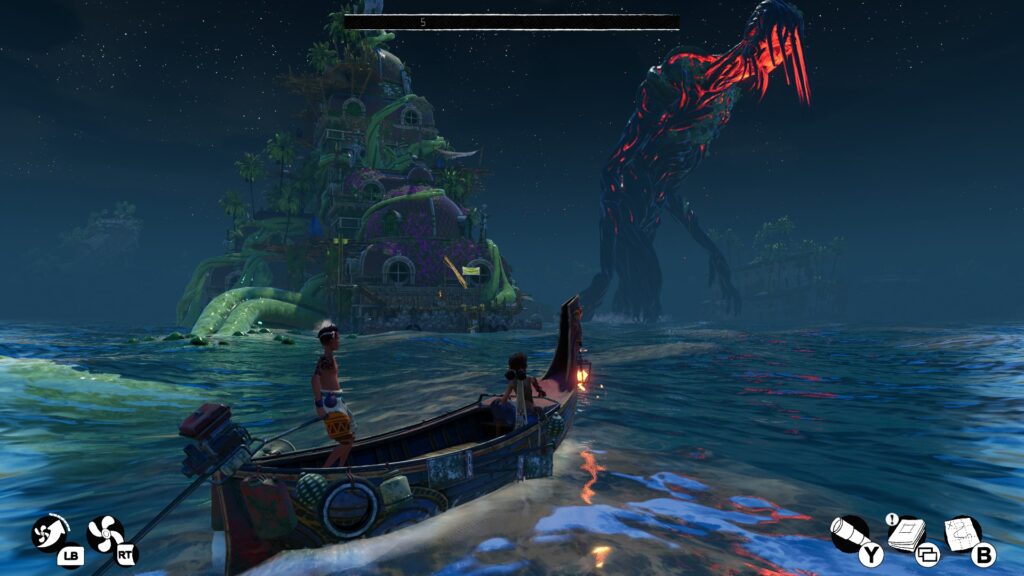
After yet another underwhelming cutscene featuring a monster that looks exactly like the one at the end of Moana, Miku and Taku excitedly say that they want to keep exploring and find all the secrets hidden throughout the flooded city. Sadly, I did not share their enthusiasm.
While your mileage may vary, and your perspective on the story can be widened through collecting more of the aforementioned diaries, I found that Submerged: Hidden Depths has nothing worth remembering even a few minutes after setting the controller down.
We did our Submerged: Hidden Depths review on PC with a review code provided by Uppercut Games. You can find additional information about Niche Gamer’s review/ethics policy here. Submerged: Hidden Depths is now available across Windows PC (via Steam), Xbox One, Xbox Series X|S, PlayStation 4, PlayStation 5, and Stadia.